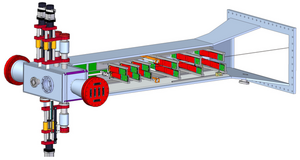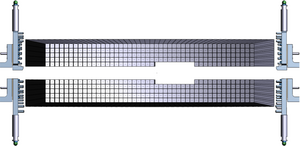Difference between revisions of "The HPS Run Wiki"
Jump to navigation
Jump to search
| Line 118: | Line 118: | ||
#* ECal Expert measures pedestals | #* ECal Expert measures pedestals | ||
#* Record FADC rates with and without the 4 um target at 100 nA, then 200 nA. Agree with last weekend? See https://logbooks.jlab.org/entry/3379417 | #* Record FADC rates with and without the 4 um target at 100 nA, then 200 nA. Agree with last weekend? See https://logbooks.jlab.org/entry/3379417 | ||
| − | |||
#* Trigger/DAQ expert checks trigger rates, DAQ, and deadtime with 200 nA beam on 4 um target. Record: | #* Trigger/DAQ expert checks trigger rates, DAQ, and deadtime with 200 nA beam on 4 um target. Record: | ||
#*# ''main scaler screen'' | #*# ''main scaler screen'' | ||
| Line 145: | Line 144: | ||
#* Include 1 hour of FEE trigger | #* Include 1 hour of FEE trigger | ||
#* Bulk of data with Pairs1 trigger | #* Bulk of data with Pairs1 trigger | ||
| − | #* | + | #* After a couple hours worth of data, tell MCC we want to work on vertical beam size with Mike Tiefenbach or Arne Freyberger. Goal is to get sigma y < 50um, sigma x <200 um. |
| − | #* | + | #* After optics exercise, resume data taking for remainder of weekend. |
=== Miscellaneous Notes: === | === Miscellaneous Notes: === | ||
Revision as of 11:59, 20 February 2016
[edit]
HPS 2016 run, February 4 to March 14, weekends only.
Shifts are manned from Friday 3pm to 7am on Monday.
Beam energy 2.3 GeV (1 pass).
Important: Document all your work in the logbook!
Spring 2015 Final @ 1 GeV:
Phone NumbersShift ScheduleShift-Taker's ChecklistHot CheckoutBeam Time AccountingRun Spreadsheet 2016, 2015 |
Procedures
|
Manuals |
JLab Logbooks
|
RC: John Jaros (Bluejeans info for Run Meetings on Thursdays and Fridays at 3pm)
- (757) 575-7540
- 9 575 7540 from Counting Room
PDL: Harut Avagyan
Run Plan for February 19 - 22, 2016:Start close-up of the Hall at 3pm on Friday, February 19 (see "General instruction" on the right)After hall is in "Beam Permit" turn on the chicane (see "Setting up Chicane for E=2.3 GeV" under "General instructions" on the right)Establish beam to the tagger dump (see "General instruction" on the right)Bring beam to FC:
Miscellaneous Notes:
|
General Instructions:Locking up the hall on Fridays
Acceptable Beam Conditions:
Recovering from beam trips when running SVT at 0.5 mm:
Every Shift:
Every Run:
Setting up Chicane for E=2.3 GeV:Note: This requires Beam Permit and NO beam to HPS / Faraday Cup.
SVT Instructions:
ECAL Instructions:
|
|
|
| ||||||||||||||||||||||||||||||||||||||||||||||||||||||||||||||||||||||||||
.
|
Webcams:
|
Accelerator: |
Slow Controls:
|
Online & Offline: |
| System/Person | Pager/Phone Number |
|---|---|
| Run Coordinator | (757) 575-7540 (cell) |
| Physics Div. Liaison | (757) 876-1789 (cell) |
| MCC-OPS | 7048 |
| Crew Chief | 7045 |
| Crew Chief | 9-879-3367 (cell) |
| Program Deputy | 9-876-7997 (cell) |
| Gate House Guard | 5822 |
| DAQ/Online | (757) 869-2188 (cell) |
| SVT | (757) 541-7539 (cell) |
| ECAL | (757) 810-1489 (cell) |
| Slow Controls | (757) 748-6922 (cell) |
| Beamline | (757) 303-3996 (cell) |
| Engineering | (757) 748-5048 |
| Hall-B Floor | 5165 |
| Hall-B Space Frame | 5170, 5171 |
| Hall-B Forward Carriage | 5371 |
| Hall-B Counting Room | 5126, 5244, 5246, 5247 |
| Hall-B Gas Shed | 7115 |


